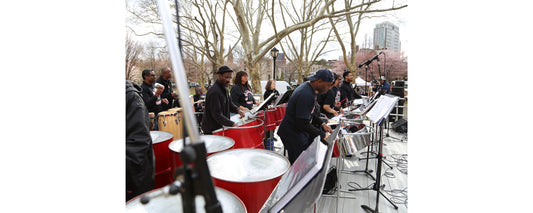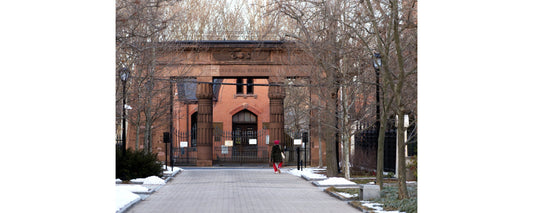It’s geometry class all over again: “A white broken line is drawn from a point equidistant to the start of the not straight yellow line, the midpoint of the blue straight line, and a point halfway between the midpoint of the right side and the upper right corner to the midpoint of the left side.”
My mind tunes out after the second or third phrase, so I back up and try again to follow the instructions penciled in large block letters in Sol LeWitt’s Wall Drawing #409. The entire wall in this fourth-floor special exhibition space at Yale University Art Gallery is painted red with a dotted white line stitched across its width. An angled blue line hovers below the white line, and a yellow squiggle like a stray thread intersects it. Up close, the penciled instructions emerge, along with guiding lines like the ones students draw with rulers across their geometry homework. With patience and attention, I follow the sequence of LeWitt’s directions, a puzzle as much grammatical as geometrical.
sponsored by
Turns out, those instructions written into Wall Drawing #409 aren’t only for the viewer. They give us a peek behind the curtain of the work. But perhaps more importantly, they gave vital direction to the artists who installed LeWitt’s work more than a decade after his death. Under the tutelage of Yale’s John Hogan, who once served as the artist’s studio assistant and is now the gallery’s installation director and archivist for his work, 15 New Haven-area artists have recreated seven of LeWitt’s drawings (three of which comprise a single work). Sol LeWitt Wall Drawings: Expanding a Legacy is on view through January 2019, and when the exhibition closes, the drawings will be painted over.
For other artists, such an ending might seem a sacrilege. But for LeWitt, the drawing isn’t the artwork; the idea is. Once he had conceived of a piece and executed it himself, the art existed, whether or not that original work did. To own a LeWitt is to own the certificate and diagram that describe each drawing in enough particular detail for it to be faithfully reproduced. Everything from the texture of the wall surface to the method of ink application is “extraordinarily systematized,” Hogan explains. That system can be taught so that “somebody who works on the drawing now is going to essentially have more or less the same result as when it was first done, so that there’s a consistency over a long period of time.”
Think of a musical composition, Hogan suggests. Bach wrote a concerto, and over time it’s performed by many different musicians with slight variations, but the essential integrity of the concerto is preserved. The concept behind LeWitt’s work is similar: he “creat
Unlike musicians playing a Bach concerto, however, installers don’t have to be virtuosos. They just have to be “receptive to wanting to learn,” Hogan says. “Specific hand skills” are required. For example, Hogan might teach a group of four people to draw a twenty-foot pencil line “that has a consistent quality and tone” by passing the pencil down the line in a particular way. They’ll practice first on four-by-four Masonite panels until they’re ready to work on the actual wall—much as a musician might practice before performing that Bach concerto. Another group of installers might need a different set of skills, such as the ability to move quickly up and down a scaffold, applying ink with rags. Once they start, they “can’t stop moving until the whole entire surface has been covered,” Hogan says.
Because of this collaboration leading to a fairly uniform result, LeWitt saw the work as “democratic.” Some pieces are designed to allow almost anyone to participate. Last December, about 120 people contributed one line each to Wall Drawing #1180, which hangs beside the gallery’s front door. The instructions are simple: “Within a 160-inch (4m) circle, draw 10,000 black straight lines and 10,000 black not straight lines. All lines are randomly spaced and equally distributed.” The result suggests a giant ball of wire, both regular and chaotic. It’s “proof that the idea works because when you see it, you only experience it as a completed artwork. It doesn’t even cross your mind that maybe 120 people had actually drawn it,” Hogan says.
Without knowing any of this, the geometry of LeWitt’s work offers its own pleasure. In Wall Drawing #334, three large side-by-side drawings mix and match primary colors with basic shapes. The left panel, for example, is yellow, with a field of evenly spaced vertical blue lines stopped at the edge of a field of evenly spaced horizontal red lines. Together they give the effect of a drawn circle, though no line delineates its edge; the ends of the horizontal and vertical lines do that. Step back and you’ll see the suggestion of an orange circle on a green field. Step up close and you’ll see the brokenness of the crayon-drawn lines, as if on a child’s piece of construction paper, despite their perfect straightness, darkness and spacing.
Wall Drawing #442 plays with an array of four triangles, each of which shares an equal side with another. Together they form a spreading figure, like a paper airplane unfolding or a parachute coming to rest. Again, the lines are absolutely precise, almost as if the shapes were cut out and glued to the wall. They’re painted with those inked rags, resulting in colors seen as muted solids from a distance and a mottled, multicolored wash up close.
On my visit, nature got in on the act, slicing an angled ray of sunlight from the louvered skylights high above down the left margin of Wall Drawing #610, which resembles a staircase tipping toward the viewer. It was a reminder of the natural world’s own geometry, lighting and fading with the passing clouds.
In addition to the seven pieces in the special exhibition, five more LeWitts are on display at the gallery, as well as nine in other Yale locations, the most accessible of which can be seen in the cafeteria, a lounge and a large conference room of the School of Management. For superfans, 105 more are on display at the Massachusetts Museum of Contemporary Art (MASS MoCA) in a 40-year retrospective of LeWitt’s work that was mounted in collaboration with Yale.
While the Yale gallery’s current special exhibition is well worth a visit, I’m still partial to Wall Drawing #786A, part of the permanent collection on the museum’s third floor. Like a giant chalkboard, its design of intersecting and connecting arcs is both beautiful and seemingly random—until you check the key on the left margin of the piece and see that there is, indeed, a logic to the leaflike dance.
Like Wall Drawing #409, it requires a bit of extra attention and patience to appreciate, as if training us to be better viewers of the rest of the art around us.
Sol LeWitt Wall Drawings: Expanding a Legacy
Yale University Art Gallery – 1111 Chapel St, New Haven (map)
Tues-Wed 10am-5pm, Thurs 10am-8pm, Fri 10am-5pm, Sat-Sun 11am-5pm
(203) 432-0600
www.artgallery.yale.edu/…
Written by Kathy Leonard Czepiel. Photos provided courtesy of the Yale University Art Gallery. Image #1 depicts detail of Wall Drawing #409; image #2 depicts Wall Drawing #610; image #3 depicts Wall Drawing #442; and image #4 depicts Wall Drawing #334.








